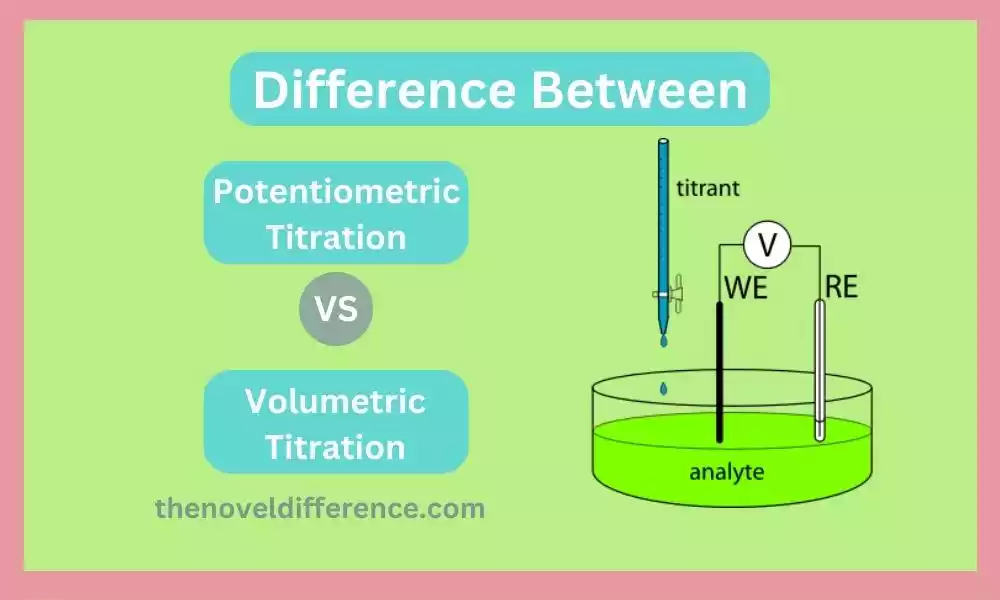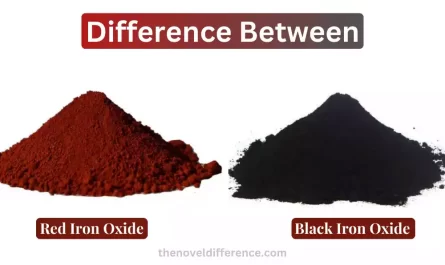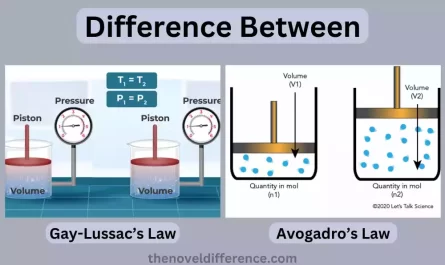Discover the key dissimilarities between volumetric and potentiometric titration techniques. This comprehensive article explores the fundamental contrasts, advantages, and applications of each method. Find out which approach best suits your analytical needs. Read on to Learn More About the Difference Between Volumetric and Potentiometric Titration.
Introduction
When it comes to chemical analysis and determining the concentration of a substance in a solution, titration methods play a crucial role. Among the various titration techniques available, two commonly employed methods are volumetric titration and potentiometric titration. While Both Approaches Aim to Achieve the Same Goal, They Differ in Terms of Their Principles, Procedures, and Applications. in This Article, We Will Delve Into the Difference Between Volumetric and Potentiometric Titration, Shedding Light on Their Unique Features and Highlighting Their Specific Uses.
Definition of Volumetric and Potentiometric Titration
Volumetric Titration: Volumetric Titration is a Quantitative Analysis Technique in Which the Concentration of a Substance in a Solution is Determined by Measuring the Volume of a Titrant (A Solution of Known Concentration) Required to React Completely With the analyte.
Potentiometric Titration: Potentiometric Titration is a Quantitative Analysis Technique That Relies on Measuring the Potential Difference (Voltage) Between Two Electrodes in a Solution to Determine the Concentration of an Analyte. The potential difference changes as the titrant is added until the endpoint of the titration is reached, indicating the completion of the reaction.
Importance of titration in analytical chemistry
Titration is of significant importance in analytical chemistry due to the following reasons:
1. Quantitative Analysis: Titration allows for the accurate determination of the concentration of a substance in a sample. This information is crucial for various applications, including quality control, drug analysis, environmental monitoring, and food analysis.
2. Versatility: Titration can be applied to a wide range of analytes, including acids, bases, redox-active species, and complex-forming substances. It provides a versatile method for determining the concentration of diverse substances in solution.
3. High Precision and Accuracy: When performed correctly, titration methods can achieve high levels of precision and accuracy in concentration measurements. This makes titration a reliable technique for obtaining quantitative data.
4. Ease of Use: Titration techniques are relatively simple and straightforward to perform, especially when compared to other analytical methods. They require minimal specialized equipment, making them accessible to a wide range of laboratories.
5. Rapid Analysis: Titration provides a rapid method for obtaining results. Depending on the titration method and the nature of the analyte, the entire analysis can be completed within minutes to a few hours.
6. Cost-Effective: Titration is generally a cost-effective analytical technique. The required reagents and equipment are often readily available and affordable. The simplicity of the method reduces the need for expensive instrumentation.
7. Process Control: Titration plays a crucial role in process control, allowing for real-time monitoring and adjustment of chemical reactions or manufacturing processes. By determining the concentration of reactants or products, titration helps ensure the desired product quality and process efficiency.
8. Educational Tool: Titration is commonly taught in analytical chemistry courses due to its fundamental principles and wide applicability. It Serves as an important Educational Tool to Develop Students’ Understanding of Chemical Reactions, Stoichiometry, and Quantitative Analysis.
Titration is a fundamental technique in analytical chemistry that provides essential information for numerous scientific, industrial, and academic applications. Its Precision, Versatility, and Ease of use Make It an indispensable Tool for Quantitative Analysis.
What is Volumetric Titration?
Volumetric titration is a quantitative analysis technique used to determine the concentration of a substance in a sample solution. It involves the addition of a solution of known concentration, called a titrant, to react with the analyte present in the sample.
The principle behind volumetric titration is based on the stoichiometry of the chemical reaction between the analyte and the titrant. The reaction is chosen such that a measurable change occurs when the reaction is complete. This change can be detected visually or by using a suitable indicator, which indicates the endpoint of the titration.
During the titration, the titrant is gradually added to the analyte solution until the endpoint is reached, indicating that the reaction between the two species is complete. The volume of titrant required to reach the endpoint is measured accurately.
By knowing the volume and concentration of the titrant, and the stoichiometry of the reaction, it is possible to calculate the concentration of the analyte in the original sample solution. This calculation is based on the concept of equivalence point, where the stoichiometric ratio between the analyte and titrant is achieved.
Volumetric titration is widely used in various fields, including pharmaceutical analysis, environmental monitoring, food analysis, and quality control. It offers a reliable and precise method for determining the concentration of a wide range of substances in solution.
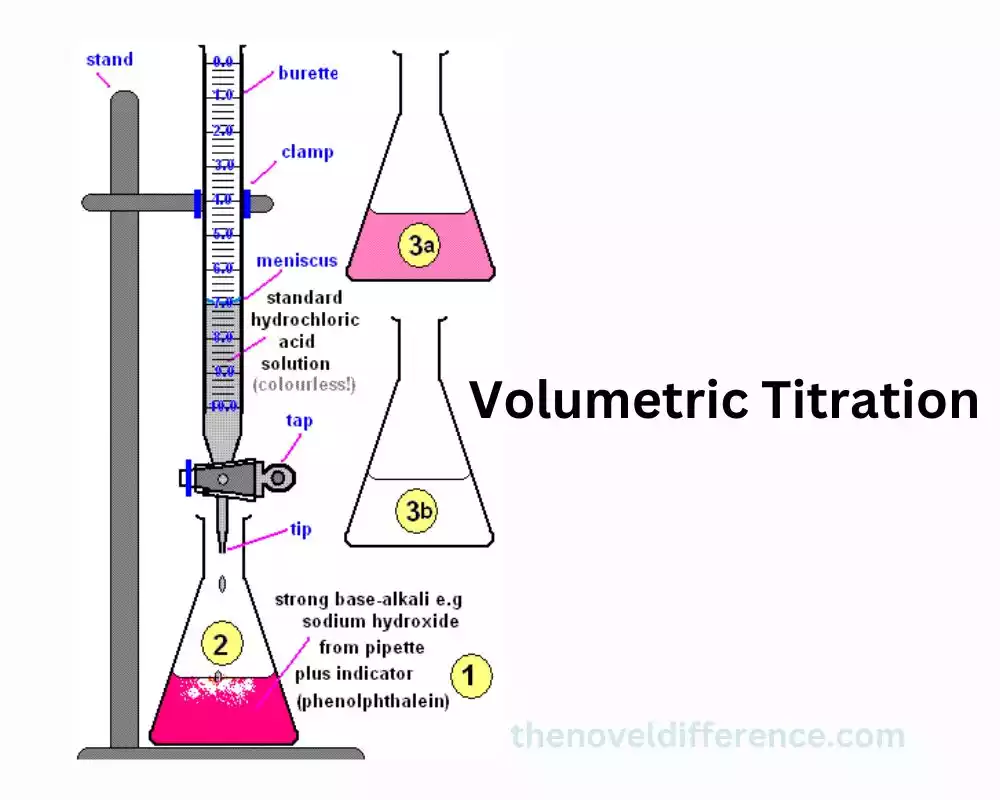
Principle of Volumetric Titration
The principle is based on the stoichiometry of the reaction between the titrant and the analyte. The balanced chemical equation provides the molar ratio between the reactants, which allows for the calculation of the concentration of the analyte. By accurately measuring the volume of the titrant required to reach the endpoint, the concentration of the analyte can be determined through simple mathematical calculations.
The procedure of Volumetric Titration
The procedure for performing a volumetric titration typically involves the following steps:
1. Preparation:
a. Ensure all necessary equipment and reagents are available and in proper working condition.
b. Prepare the analyte solution by accurately measuring a known volume of the sample and transferring it to a clean titration flask or beaker.
c. If required, adjust the pH or add any necessary buffer solutions to the analyte solution.
2. Selection of Titrant and Indicator:
a. Choose a suitable titrant, which is a solution of known concentration that reacts with the analyte.
b. Select an appropriate indicator, if necessary, to visually indicate the endpoint of the titration. The indicator should change color at or near the equivalence point.
3. Titration Process:
a. Set up the burette by rinsing it with the titrant solution and filling it with the titrant, ensuring the meniscus is at the zero mark.
b. Record the initial volume (initial burette reading) of the titrant solution.
c. Add a few drops of the indicator (if used) to the analyte solution.
d. Slowly add the titrant solution from the burette into the analyte solution while swirling the flask or beaker.
e. As the titration progresses, observe any color changes in the solution, paying attention to the appearance of the endpoint.
f. Towards the endpoint, slow down the addition of the titrant, drop by drop, until the indicator or other detection method shows the completion of the reaction. This is the endpoint of the titration.
4. Final Burette Reading:
a. Once the endpoint is reached, record the final volume (final burette reading) of the titrant solution. Note the volume added during the titration.
5. Calculation of Results:
a. Calculate the volume of titrant used by subtracting the initial burette reading from the final burette reading.
b. Use the stoichiometry of the reaction and the known concentration of the titrant to calculate the concentration of the analyte in the original sample solution.
6. Repeat and Average:
a. Repeat the titration process at least two more times to ensure accuracy and precision.
b. Calculate the average volume of titrant used and the corresponding analyte concentration.
It is important to follow good laboratory practices, accurately measure volumes, and perform appropriate calculations to obtain reliable and accurate results during the volumetric titration procedure.
What is Potentiometric Titration?
Potentiometric titration is a quantitative analysis technique used to determine the concentration of an analyte in a sample solution based on measuring the potential difference (voltage) between two electrodes in the solution.
The principle behind potentiometric titration is based on the concept that the potential difference between two electrodes changes as the titrant is added to the analyte solution. This potential difference is measured using a potentiometer or pH meter equipped with a suitable electrode system.
During potentiometric titration, a titrant solution of known concentration is gradually added to the analyte solution. As the titrant reacts with the analyte, the concentration of ions in the solution changes, leading to a change in the potential difference at the electrode system.
The endpoint of the titration is determined by observing a sudden and significant change in the potential difference, indicating the completion of the reaction between the analyte and titrant. This change in potential difference corresponds to the equivalence point, where the stoichiometric ratio between the analyte and titrant is achieved.
Potentiometric titration offers several advantages, including high accuracy, precision, and the ability to determine the endpoint more precisely compared to visual indicators. It is particularly useful for titrations involving weak acids or bases, as well as redox reactions.
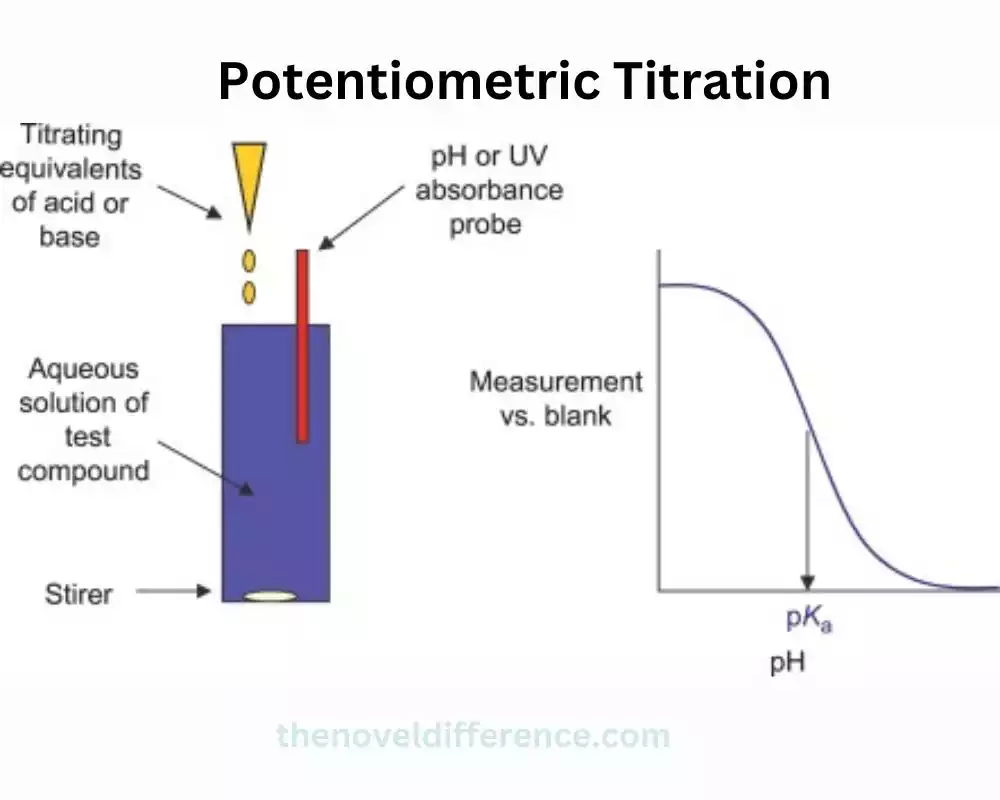
To perform a potentiometric titration, the following steps are typically followed:
1. Preparation:
a. Ensure all necessary equipment and electrodes are clean and in good working condition.
b. Prepare the analyte solution and ensure it is ready for titration.
2. Electrode Calibration:
a. Calibrate the potentiometer or pH meter using standard solutions of known pH or potential difference.
b. Calibrate the reference electrode to ensure accurate measurements.
3. Titrant Addition:
a. Fill the burette with the titrant solution of known concentration.
b. Immerse the indicator electrode and reference electrode into the analyte solution.
c. Start adding the titrant solution dropwise to the analyte solution, while monitoring the potential difference using the potentiometer or pH meter.
4. Endpoint Detection:
a. Continuously monitor the potential difference as the titration progresses.
b. Observe a sudden change in the potential difference, indicating the endpoint of the titration.
c. Record the volume of titrant solution added at the endpoint.
5. Calculation of Results:
a. Use the volume of titrant added at the endpoint, along with the known concentration of the titrant, to calculate the concentration of the analyte in the original sample solution.
Potentiometric titration offers a precise and accurate method for determining the concentration of a wide range of analytes. It is commonly used in various fields, including pharmaceutical analysis, environmental monitoring, and chemical research.
Principle of Potentiometric Titration
The principle behind potentiometric titration is based on the concept of electrochemical cells. The electrodes used in the titration setup are typically a reference electrode and an indicator electrode. The reference electrode maintains a constant potential, while the indicator electrode detects changes in potential due to the reaction between the analyte and the titrant. By measuring the potential difference, the endpoint of the titration can be determined.
The procedure of Potentiometric Titration
The procedure for performing a potentiometric titration typically involves the following steps:
1. Preparation:
a. Ensure all necessary equipment, including electrodes, potentiometer or pH meter, and titrant solutions, are clean and in good working condition.
b. Prepare the analyte solution by accurately measuring a known volume of the sample and transferring it to a suitable titration vessel.
2. Electrode Calibration:
a. Calibrate the potentiometer or pH meter using standard solutions of known pH or potential difference to ensure accurate measurements.
b. Calibrate the reference electrode according to the manufacturer’s instructions to establish a stable reference potential.
3. Setup:
a. Immerse the indicator electrode and the reference electrode into the analyte solution.
b. Connect the indicator electrode to the working electrode input of the potentiometer or pH meter and the reference electrode to the reference electrode input.
4. Titrant Addition:
a. Fill the burette with the titrant solution of known concentration.
b. Start adding the titrant solution to the analyte solution slowly and continuously while stirring the solution or using a magnetic stirrer.
c. Observe the potential difference reading on the potentiometer or pH meter as the titration progresses.
5. Endpoint Detection:
a. Continue adding the titrant solution until a sudden change or plateau in the potential difference reading occurs. This change indicates the endpoint of the titration.
b. Take note of the volume of titrant solution added at the endpoint.
6. Calculation of Results:
a. Use the volume of titrant added at the endpoint, along with the known concentration of the titrant, to calculate the concentration of the analyte in the original sample solution based on the stoichiometry of the reaction.
b. Apply any necessary corrections or adjustments, such as dilution factors, if applicable.
7. Repeat and Average:
a. Repeat the titration process at least two more times to ensure accuracy and precision.
b. Calculate the average volume of titrant used and the corresponding analyte concentration.
It is important to carefully follow the manufacturer’s instructions for the potentiometer or pH meter and electrodes used, as well as good laboratory practices, to obtain reliable and accurate results during the potentiometric titration procedure.
Difference between Volumetric and Potentiometric Titration
The main differences between volumetric titration and potentiometric titration are as follows:
Measurement Technique:
• Volumetric Titration: Volumetric titration relies on measuring the volume of a titrant solution required to react completely with the analyte. The concentration of the analyte is calculated based on the known concentration and volume of the titrant added.
• Potentiometric Titration: Potentiometric titration measures the potential difference (voltage) between two electrodes in the solution as the titration progresses. The potential difference changes as the concentration of ions in the solution changes. The concentration of the analyte is determined by detecting the endpoint where a sudden change in potential difference occurs.
Endpoint Determination:
• Volumetric Titration: Volumetric titration typically uses visual indicators or other detection methods, such as color change, to determine the endpoint of the titration. The indicator changes color when the reaction between the analyte and titrant is complete.
• Potentiometric Titration: Potentiometric titration determines the endpoint by monitoring the potential difference. The endpoint is identified as the point where there is a sudden and significant change in the potential difference.
Sensitivity and Accuracy:
• Volumetric Titration: Volumetric titration can provide high accuracy when performed carefully. However, the accuracy may be affected by factors such as human observation errors and the sensitivity of visual indicators.
• Potentiometric Titration: Potentiometric titration offers high sensitivity and accuracy as the potential difference can be measured precisely. It allows for a more precise determination of the endpoint, resulting in improved accuracy compared to visual indicators.
Speed and Automation:
• Volumetric Titration: Volumetric titration can be relatively time-consuming, especially when precise endpoint determination is required. It is typically performed manually, and automation options are limited.
• Potentiometric Titration: Potentiometric titration can be faster compared to volumetric titration as the endpoint can be detected more precisely and quickly. Automated systems can be used for accurate and efficient potentiometric titrations.
Advantages and Limitations:
• Volumetric Titration: Volumetric titration is widely applicable, relatively simple to perform, and requires minimal specialized equipment. However, it may be less precise than potentiometric titration and relies on visual indicators, which can introduce errors.
• Potentiometric Titration: Potentiometric titration offers higher precision, accuracy, and sensitivity compared to volumetric titration. It can be used for a wide range of analytes and provides more precise endpoint determination. However, it requires specialized equipment, including electrodes and a potentiometer or pH meter.
The Choice Between Volumetric Titration and Potentiometric Titration Depends on Factors Such as the Nature of the Analyte, Required Accuracy, Sensitivity, and Available Equipment. Potentiometric titration is particularly advantageous when high precision and accuracy are essential.
Conclusion
The difference between volumetric and potentiometric titration lies in their underlying principles, detection methods, accuracy, and applications. Volumetric titration, based on visual indicators and stoichiometry, is versatile and cost-effective, suitable for a wide range of titration types.
Potentiometric titration, relying on measuring potential differences, offers higher accuracy and sensitivity, making it ideal for weak acid-base and redox titrations. The Choice Between These Two Methods Depends on the Specific Analytical Requirements, the Nature of the Analyte, and the Desired Level of Precision. By understanding the unique characteristics of each technique, scientists and chemists can select the most appropriate titration method for their experiments and analyses.

